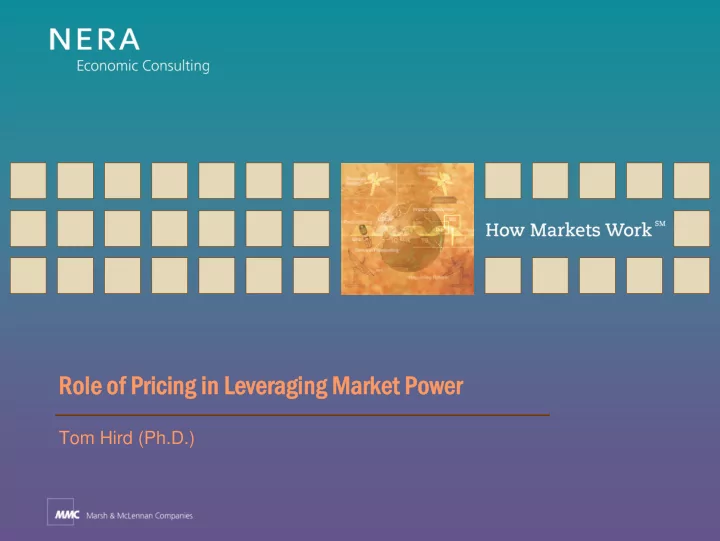

Role of Pricing in Leveraging Market Power Role of Pricing in Leveraging Market Power Tom Hird (Ph.D.)
Background Background Monopolists often operate, or want to operate, in markets that are downstream to their monopoly infrastructure (bottleneck). • Telstra operates in long distance; • EnergyAustralia retails electricity in its distribution area; • AGL retails gas in its distribution area
Some Questions Some Questions Should vertical integration be encouraged or discouraged? If vertically integrated, should monopolists be allowed to charge themselves less than rivals for the bottleneck? Does the monopolist have to sacrifice short term profits to engage in a ‘price squeeze’ of efficient rivals?
Vertical Price Squeeze Vertical Price Squeeze Imputation Test P I DS =P R Downstream DS C DS C DS Cost � Bottleneck W Access W Price Incumbent Downstream Rival C DS P I DS < P R DS X C DS W W Incumbent
Relax Imputation Test? Relax Imputation Test? Should imputation test be relaxed to allow the monopolist freedom to charge itself less than W? • Yes, say Armstrong (1996), Weisman (2002) and Degraba (2003) • Allow monopolist to price according to its opportunity cost
Relax Imputation Test? Relax Imputation Test? Opp. Cost = (W-MC)* γ + MC γ = ‘diversion ratio’ (if γ =1 then every additional downstream sale by the monopolist results in one less access sale) If diversion ratio equals zero then external access price (W) should place no constraint on monopolist’s pricing
Some Tensions Some Tensions • Allowing monopolist to sell access to itself at less than W can increase consumer welfare • If discount still leaves price above opportunity cost it need not be sacrificing any profits (no clear predatory intent) BUT • Equally efficient downstream rivals suffer loss of addressable market • Diversion ratio is less than 1 for both firms, why does only one get the discount?
Resolutions Resolutions Can these tensions be resolved? Can we protect both consumers and competition simultaneously? Three options (from easiest to hardest): • Price access at marginal cost • Adopt the Efficient Component Pricing Rule (not discussed) • Implement strict vertical separation (not discussed)
Resolutions Resolutions So long as W>MC: • the monopolist can profitably lower its marginal downstream prices to better reflect marginal cost (eg, through two part tariffs) BUT • Rivals can not match the monopolist as, unlike the monopolist, they face a marginal cost for using the bottleneck of W not MC
Resolutions Resolutions Set marginal access price at marginal production cost Recall Opp. Cost = (W-MC)* γ + MC If W=MC then diversion ratio is irrelevant and no reason exists for incumbent to sell itself discounted access
Regulatory Practice Regulatory Practice Two part access tariffs are popular because they tend to send efficient signals to consumers This preceding analysis suggests that they also reduce the scope for vertically integrated monopolists to leverage market power Two part access tariffs are used in Australia to set marginal access prices closer to marginal cost in energy distribution There is more scope to use them in telecommunications
Final Thoughts Final Thoughts Regulators concerned about exercise of market power may have to be just as concerned with access price structure as level A stand alone bottleneck owner has incentive to set marginal access price at marginal cost for all downstream firms There is cause for suspicion if a vertically integrated firm does not negotiate lower marginal prices with access seekers but does set its own marginal retail prices as if it paid marginal cost
Stylised Example Stylised Example Marginal cost of bottleneck is zero Constant returns to scale in downstream production (ie, ‘perfect competition’ in downstream market) All consumers have identical demand for downstream good
All firms pay W per unit $ D Representative P DS “Fixed Lost W Bottleneck Costs Potential Per Customer” Efficiency MC = C DS C DS Output X
Monopolist Charges Two Part Tariff $ D representative Satisfies Standard Imputation Test P DS Fails Standard W Fixed Imputation Test Additional charge Surplus Generated MC = C DS C DS Variable Charge=MC Output Y X
In Words In Words No downstream price discrimination => Imputation test passed => downstream competition is “on merits” But => Unserved demand and inefficient utilisation of the bottleneck Downstream price discrimination => Imputation test failed => downstream rivals squeezed But => Bottleneck used efficiently
Recommend
More recommend